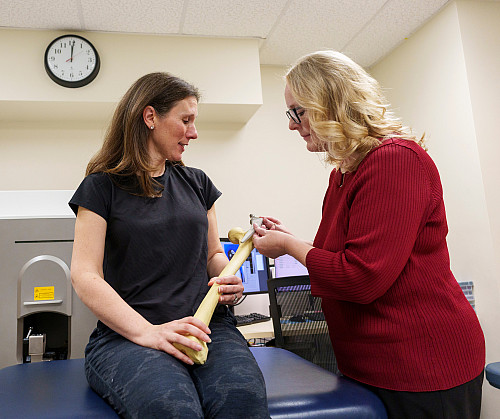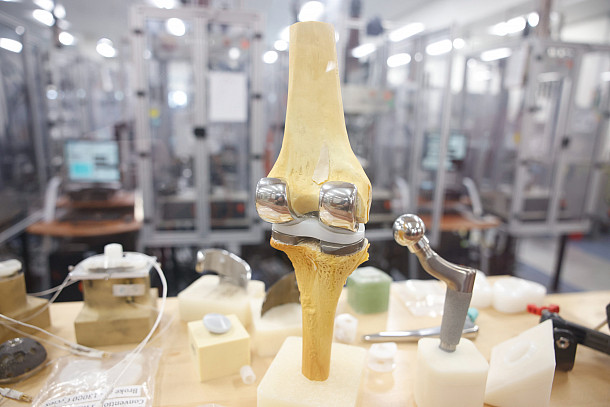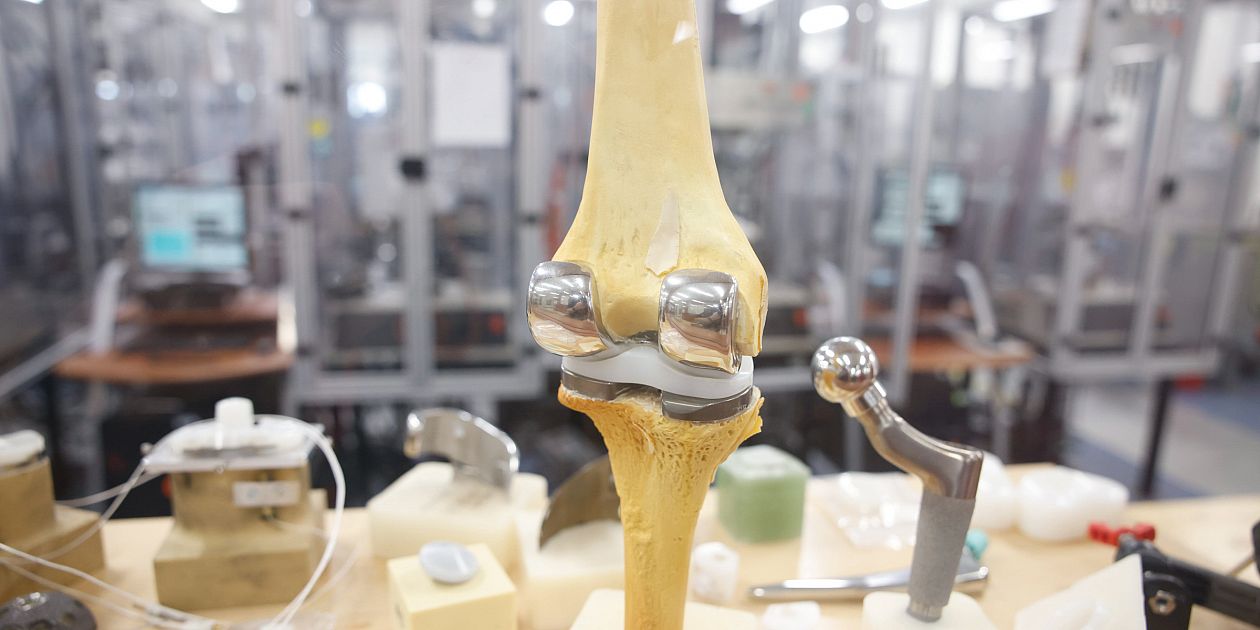Increasing Hoosiers’ mobility so they can live more fulfilling lives is at the center of the Indiana Musculoskeletal Health Partnership for the Advancement of Care & Treatment mission. The statewide consortium, known as IMPACT, aims to restore the health of patients with osteoporosis, arthritis and other musculoskeletal disorders or injuries. The musculoskeletal system refers to the body’s structure and strength network, encapsulating bones, muscles, joints, tendons, ligaments and cartilage.
A child breaks a bone on the playground. An athlete tears a knee ligament. A senior adult can no longer live independently due to a broken hip. Musculoskeletal injuries and disorders affect all walks of life.
Through research and development, and workforce and educational training, IMPACT is advancing Indiana’s thriving orthopedic industry. The consortium collaborates with more than 100 research, industry and clinical partners statewide, including Eli Lilly, Zimmer Biomet, OrthoIndy, University of Notre Dame and Purdue University. It is expected to bring more than 2,000 jobs and $583 million in economic activity to the state.
The U.S. National Science Foundation named the consortium as a Regional Innovation Engine finalist. The competition will fund programs that build and scale regional ecosystems around critical industries that drive economic growth.
“In order for Hoosiers to have the life they want, they need to be able to move well,” said Melissa Kacena, the consortium’s principal investigator. “Whether it’s picking up your grandkids, running a marathon or being able to work, if we can’t move the way we want to, we aren’t living our best lives.”
Leading the consortium is a cross-collaborative team of IU researchers who combine expertise in clinical studies, pharmacology and supply chain management.
Kacena is the director of the IU School of Medicine’s Indiana Center for Musculoskeletal Health and a leading bone researcher. Her research focuses on developing drug technologies to accelerate bone recovery, a breakthrough that has attracted attention from NASA and the U.S. Department of Defense. Both organizations see the treatment’s potential to help astronauts preserve bone mass in space and heal soldiers recovering from explosives injuries.
Jill Fehrenbacher, a neuroscientist at the IU School of Medicine, is IMPACT’s chief learning officer. Amrou Awaysheh, a faculty member at the IU Kelley School of Business, serves as chief technology and innovation officer. Jim Lancaster, an orthopedic innovation executive, is the interim CEO.
An aging nation

A common health concern is bone fractures. According to Kacena, 50% of women and 25% of men over the age of 50 will suffer from a bone fracture in their lifetime due to low bone density.
Suffering any kind of musculoskeletal injury can have devastating effects. It’s estimated that 300,000 hip fractures occur in the U.S. each year. Studies show that 20% to 30% of elderly people who fracture a hip die within a year.
Musculoskeletal conditions are a leading cause of absenteeism in the workplace and account for nearly 20% of primary-care physician visits. In 2018, these conditions cost the U.S health care system $420 billion.
Warsaw, Indiana: The world’s orthopedic capital
IMPACT is building on the already competitive orthopedic industry in Warsaw, Indiana.
Stretching 50 miles along U.S. 30 from Warsaw to Fort Wayne, Indiana, a cluster of more than 25 medical device companies and manufacturers earned the region its fitting nickname: “MedTech Corridor.” Known as the orthopedic capital of the world, Warsaw is home to notable orthopedic manufacturers such as DePuy Synthes and Zimmer Biomet.
Warsaw’s reputation for orthopedic innovation dates to 1895, when Revra DePuy created fiber and then wire splints, a safer alternative to the barrel stave splint physicians were using. Fast forward more than a century later, and Warsaw claims almost two-thirds of the world’s market share for orthopedic devices.
“Warsaw is more than just the orthopedic capital of the world; it’s a hub for innovation, where world-class manufacturers and researchers work to advance technologies that improve mobility and quality of life for Hoosiers,” Lancaster said. “Through IMPACT, we’ll foster a thriving life sciences ecosystem and strengthen Indiana’s economy.”

Research that moves
IU researchers are working with manufacturers to ensure they can keep pace with swift technology advancements.
Through the IU Business Sustainability and Innovation Lab at the Kelley School, which Awaysheh directs, he and over 110 master’s students helped a Warsaw orthopedic manufacturer examine opportunities to leverage AI to create more responsive supply chains. This allows data collection and adaptation in real time, making processes more cost efficient, more responsive and smarter and provides physicians with more accurate implants quicker.
“Our work also extends beyond the supply chain into digitizing manufacturing,” Awaysheh said. “Think of your house. Older homes have light switches and dial thermostats. Now you see smart switches that sense when someone enters the room, and we can control the temperature remotely to only be on when the space is being used.
“These same principles are going to advance manufacturing. We can use similar concepts to digitize legacy manufacturing lines.”
Kacena is launching a mobile testing unit to make preventive care more accessible to aging and rural communities.
MSKMobile is a fully equipped mobile healthcare screening and research tool. It will travel across Indiana to test volunteers’ gait speed, grip strength, bone mineral density and other important markers of musculoskeletal health. It is an expansion of the Indiana Center for Musculoskeletal Health’s Function, Imaging and Testing Core.
Training this generation and the next
Fehrenbacher, who will develop educational and workforce training programs, said that sparking students’ STEM interest early is key.
MSKTrain, the consortium’s STEM education program, will reach students across Indiana. Warsaw has led the way with early STEM exposure, using a mobile STEM bus to bring hands-on learning to elementary schools. MSKTrain will expand that model to rural areas, aligning curriculum with state standards so teachers can integrate lessons easily into the classroom.
To ensure a skilled workforce, Fehrenbacher is exploring innovative solutions like augmented reality with haptic feedback to provide immersive, hands-on training. MSKTrain’s goal is to partner with upskilling programs at Ivy Tech Community College and OrthoWorx to provide relevant training and credentials.
“To grow Indiana’s STEM workforce, we need to spark interest early and support students through high school with tools to guide their paths,” Fehrenbacher said. “We’re also prioritizing flexible upskilling programs, like the AR training, to meet people where they are and prepare them for real jobs, faster.”
